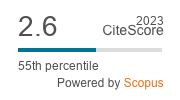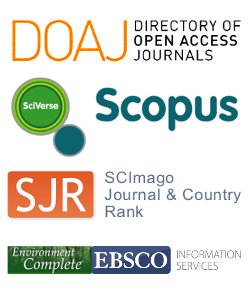Landscape painting as a visual representation of geographic processes: a critical and educational perspective
DOI:
https://doi.org/10.3097/LO.2025.1136Keywords:
landscape painting, art-based learning, geographic education, climate zonesAbstract
Contemporary geography education highlights the need for interdisciplinary and visually enriched pedagogies that engage students both cognitively and emotionally. Within this framework, landscape painting emerges as an effective educational tool, as it captures the physical, cultural, and emotional dimensions of the environment. The study offers a critical analysis of 18 paintings representing diverse climate and landscape zones, including tropical rainforests, savannas, hot and cold deserts, Mediterranean vegetation, steppes, temperate forests, tundra, and taiga. These artworks provide accessible visual platforms for discussing environmental features, seasonal changes, and human–environment interactions while offering insights into symbolic and cultural meanings. However, stylized representations may also introduce biases or misconceptions, necessitating pedagogical mediation. The study emphasizes the importance of balancing artistic aesthetics with geographical precision to optimize educational value. Ultimately, landscape paintings can serve as a valuable bridge between abstract geographical concepts and multisensory, tangible learning experiences.
References
Amoroso, N. 2012. Representing landscapes: A visual collection of landscape architectural drawings. Routledge. https://doi.org/10.4324/9780203152164
Arts, B., Buizer, M., Horlings, L., Ingram, V., Van Oosten, C., & Opdam, P. 2017. Landscape approaches: a state-of-the-art review. Annual Review of Environment and Resources, 42(1), pp.439-463. https://doi.org/10.1146/annurev-environ-102016-060932
Ballard, S., & Linden, L. 2019. Spiral Jetty, geoaesthetics, and art: Writing the Anthropocene. The Anthropocene Review, 6(1-2), pp.142-161. https://doi.org/10.1177/2053019619839443
Baomar, Z. S. A. A., & Sanad, R. 2021. A study of landscape painting development–Past, present and future perspectives. New Trends and Issue Proceedings on Humanities and Social Sciences, 8(1), pp.01-11. https://doi.org/10.18844/prosoc.v8i1.5774
Berleant, A. 1997. Living in the landscape: Toward an aesthetics of environment. University press of Kansas.
Bishop, E. W. 1922. Suggestions for the Use of Pictures in Teaching Geography. The Geographical Teacher, 11(5), pp.301-304. https://www.jstor.org/stable/i40024296
Birksted, J. 2003. Landscape history and theory: from subject matter to analytical tool. Landscape Review, 8(2), pp.4-28. https://doi.org/10.34900/lr.v8i2.109
Bunkše, E. V. 2007. Feeling is believing, or landscape as a way of being in the world. Geografiska Annaler: Series B, Human Geography, 89(3), pp.219-231. https://doi.org/10.1111/j.1468-0467.2007.00250.x
Butlin, R. A. 2009. Geographies of empire: European empires and colonies, c. 1880-1960, Cambridge: Cambridge University Press, https://doi.org/10.1162/JINH_r_00064
Carlson, A. 2009. Nature and landscape: an introduction to environmental aesthetics. Columbia University Press. https://www.jstor.org/stable/10.7312/carl14040
Castree, N., Demeritt, D., & Liverman, D. (2009). Introduction: Making Sense of Environmental Geography. A Companion to Environmental Geography (1st ed., pp. 1-15). John Wiley & Sons
Ltd. https://doi.org/10.1002/9781444305722.ch1
Cheung, C. K., & Jhaveri, A. D. 2016. Developing students' critical thinking skills through visual literacy in the New Secondary School Curriculum in Hong Kong. Asia Pacific Journal of Education, 36(3), pp.379-389. https://doi.org/10.1080/02188791.2014.959470
Cock, E. M. 1967. The influence of photography on American landscape painting, 1839-1880. New York University.
Constable, W. G. 1964. An Early Painting of Rome by Canaletto. The Burlington Magazine, 106(740), pp.509-512. http://www.jstor.org/stable/874431
Corner, J. 1992. Representation and landscape: Drawing and making in the landscape medium. Word & Image, 8(3), pp.243-275. https://doi.org/10.1080/02666286.1992.10435840
Cosgrove, D. E. 1998. Social formation and symbolic landscape. University of Wisconsin Press.
Courtauld Institute of Art. 1938. Overzicht der Litteratuur betreffende Nederlandsche Kunst. Oud Holland, pp.223-227. http://www.jstor.org/stable/42718798.
Cupchik, G. C., & Gebotys, R. J. 1988. The search for meaning in art: Interpretive styles and judgments of quality. Visual Arts Research, pp.38-50. https://www.jstor.org/stable/20715675
Dahlan, A. G. 2014. The Scream & Starry Night: Emotions, symbol & motives. Estudios Sobre el Mensaje Periodistico, 20(1), pp.331-339. http://dx.doi.org/10.5209/rev-ESMP.2014.v20.n1.45235
Daniels, S. 1993. Fields of vision: Landscape imagery and national identity in England and the United States, Princeton, Princeton University Press.
De Blij, H. 2008. The power of place: Geography, destiny, and globalization's rough landscape. Oxford University Press.
De Menezes, C. 2004. Terra firma: contemporary representations of the South African landscape (Doctoral dissertation).
Di Palma, V. 2015. Is landscape painting?. In Is Landscape...? (pp. 44-70). Routledge. https://doi.org/10.4324/9781315697581
Gergel, S. E., Gergel, S. E., Turner, M. G., & Turner, M. G. (2017). Learning landscape ecology a practical guide to concepts and techniques. Springer. https://doi.org/10.1007/978-1-4939-6374-4
Gibson, W. S. 2000. Pleasant places: the rustic landscape from Bruegel to Ruisdael. University of California Press.
Gradle, S. (2007). Ecology of place: Art education in a relational world. Studies in art education, 48(4), 392-411. https://doi.org/10.1080/00393541.2007.11650116
Griffin, A. L., & Fabrikant, S. I. (2012). More maps, more users, more devices means more cartographic challenges. Cartographic Journal, 49(4), pp.298–301. https://doi.org/10.1179/0008704112Z.00000000049
Gude, O. 2004. Postmodern principles: In search of a 21st century art education. Art Education, 57(1), pp.6-14. https://doi.org/10.1080/00043125.2004.11653528
Halverson, L. H. 1929. Pictures in the Teaching of Geography. Journal of Geography, 28(9), pp.357-368. https://doi.org/10.1080/00221342908984986
Hodgson, D. 2000. Art, perception and information processing: an evolutionary perspective. Rock Art Research, 17(1), pp.3-34.
Hussain, M. A., Mohd Yunos, M. Y., Ismail, N. A., Ariffin, N. F. M., & Ismail, S. 2020. A review of the elements of nature and the Malay cultural landscape through Malay literature. Sustainability, 12(6), pp.2154. https://doi.org/10.3390/su12062154
Jones, M. 1991. The elusive reality of landscape. Concepts and approaches in landscape research. Norsk Geografisk Tidsskrift - Norwegian Journal of Geography, 45(4), pp.229–244. https://doi.org/10.1080/00291959108552277
Joshi, D., Datta, R., Fedorovskaya, E., Luong, Q. T., Wang, J. Z., Li, J., & Luo, J. 2011. Aesthetics and emotions in images. IEEE Signal Processing Magazine, 28(5), pp.94-115. https://doi.org/10.1109/MSP.2011.941851
Kwa, C. 2018. The visual grasp of the fragmented landscape: Plant geographers vs. plant sociologists. Historical Studies in the Natural Sciences, 48(2), 180-222. https://doi.org/10.1525/hsns.2018.48.2.180
Lai, A. 2021. Creating project-based learning for online art classrooms. Journal of Effective Teaching in Higher Education, 4(1), pp.94-108. https://doi.org/10.36021/jethe.v4i1.66
Li, J., Yang, L., Pu, R., & Liu, Y. 2017. A review on anthropogenic geomorphology. Journal of Geographical Sciences, 27, pp.109-128. https://doi.org/10.1007/s11442-017-1367-7
Lowrie, T., Logan, T., & Hegarty, M. 2019. The influence of spatial visualization training on students’ spatial reasoning and mathematics performance. Journal of Cognition and Development,20(5),pp.729-751. https://doi.org/10.1080/15248372.2019.1653298
Madge, C. (2014). On the creative (re) turn to geography: Poetry, politics and passion. Area, 46(2), 178-185. https://doi.org/10.1111/area.12097
Marcus, A. P. (2023). Using “Autogeography,” sense of place and place-based approaches in the pedagogy of geographic thought. Journal of Geography in Higher Education, 47(1), 71-84. https://doi.org/10.1080/03098265.2021.1991290
Marinova, E., Tonkov, S., Bozilova, E., & Vajsov, I. 2012. Holocene anthropogenic landscapes in the Balkans: the palaeobotanical evidence from southwestern Bulgaria. Vegetation history and archaeobotany, 21, pp.413-427. https://doi.org/10.1007/s00334-011-0345-8
Menninghaus, W., Wagner, V., Wassiliwizky, E., Schindler, I., Hanich, J., Jacobsen, T., & Koelsch, S. 2019. What are aesthetic emotions?. Psychological review, 126(2), pp.171. https://doi.org/10.1037/rev0000135
Morin, K. M. (2009). Landscape: representing and interpreting the world. In N. J. Clifford, S. L. Holloway, S. P. Rice, G. Valentine (Eds), Key concepts in geography (2nd ed.) pp. 286-299. London: SAGE.
Novak, B. 2007. Nature and Culture: American Landscape and Painting, 1825-1875, With a New Preface. Oxford University Press.
Osama Mohammed Fikry, N., & ElFiki, S. 2020. Teachers’ interpretation of “learning through landscapes” in Egyptian school grounds. Engineering Research Journal, 168, pp.325-342. http://dx.doi.org/10.21608/erj.2020.150980
Raappana-Luiro, L. 2024. Miracle of nature—dialog with nature through artistic creation. Frontiers in Communication, 9, 1440368. https://doi.org/10.3389/fcomm.2024.1440368
Rockman, D. A. 2000. The art of teaching art: A guide for teaching and learning the foundations of drawing-based art. Oxford University Press.
Rogers, A. 2012. Geographies of the performing arts: Landscapes, places and cities. Geography Compass, 6(2), pp.60-75. https://doi.org/10.1111/j.1749-8198.2011.00471.x
Seibold, U. 1990. Meteorology in Turner's paintings. Interdisciplinary Science Reviews, 15(1), pp.77-86. https://doi.org/10.1179/isr.1990.15.
Siama, I., Terkenli, T. S., & Klonari, A. 2020. Implementing a landscape educational project among Greek pupils: Valuable lessons and hard realizations. International Journal of Education (IJE), 8(1), pp.39-53. https://doi.org/10.5121/ije.2020.8103
Small, C., & Sousa, D. 2016. Humans on Earth: Global extents of anthropogenic land cover from remote sensing. Anthropocene, 14, pp.1-33. https://doi.org/10.1016/j.ancene.2016.04.003
Thomashow, M. (2001). Bringing the biosphere home: Learning to perceive global environmental change. MIT Press. https://doi.org/10.29173/cmplct8751
Thornes, J. E. 2008. A rough guide to environmental art. Annual Review of Environment and Resources, 33(1), pp.391-411. https://doi.org/10.1146/annurev.environ.31.042605.134920
Ultee, M. 1988. The Riches of the Dutch Seventeenth Century. The Seventeenth Century, 3(2), pp.223-242.
Wang, J. A., Liang, S., & Shi, P. 2022. Topography and Landforms. In The Geography of Contemporary China (pp. 63-84). Cham: Springer International Publishing. https://doi.org/10.1007/978-3-031-04158-7_3
Van Der Hoeven Kraft, K. J., Srogi, L., Husman, J., Semken, S., & Fuhrman, M. 2011. Engaging students to learn through the affective domain: A new framework for teaching in the geosciences. Journal of Geoscience Education, 59(2), pp.71-84. https://doi.org/10.5408/1.3543934a
Viviroli, D., Archer, D. R., Buytaert, W., Fowler, H. J., Greenwood, G. B., Hamlet, A. F., ... & Woods, R. 2011. Climate change and mountain water resources: overview and recommendations for research, management and policy. Hydrology and Earth System Sciences, 15(2), pp.471-504. https://doi.org/10.5194/hess-15-471-2011

Downloads
Published
How to Cite
Issue
Section
Categories
License
Copyright (c) 2025 Bartosz Korinth

This work is licensed under a Creative Commons Attribution 4.0 International License.










